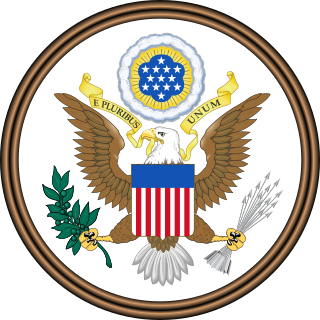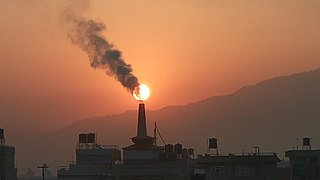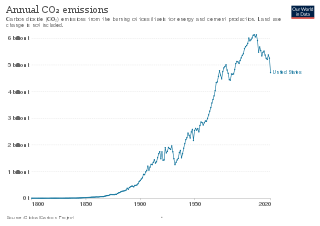Related Research Articles

Emissions trading is a market-based approach to controlling pollution by providing economic incentives for reducing the emissions of pollutants. The concept is also known as cap and trade (CAT) or emissions trading scheme (ETS). One prominent example is carbon emission trading for CO2 and other greenhouse gases which is a tool for climate change mitigation. Other schemes include sulfur dioxide and other pollutants.

Hazardous waste is waste that has substantial or potential threats to public health or the environment. Hazardous waste is a type of dangerous goods. They usually have one or more of the following hazardous traits: ignitability, reactivity, corrosivity, toxicity. Listed hazardous wastes are materials specifically listed by regulatory authorities as hazardous wastes which are from non-specific sources, specific sources, or discarded chemical products. Hazardous wastes may be found in different physical states such as gaseous, liquids, or solids. A hazardous waste is a special type of waste because it cannot be disposed of by common means like other by-products of our everyday lives. Depending on the physical state of the waste, treatment and solidification processes might be required.

The Environmental Protection Agency (EPA) is an independent agency of the United States government tasked with environmental protection matters. President Richard Nixon proposed the establishment of EPA on July 9, 1970; it began operation on December 2, 1970, after Nixon signed an executive order. The order establishing the EPA was ratified by committee hearings in the House and Senate.

Industrial waste is the waste produced by industrial activity which includes any material that is rendered useless during a manufacturing process such as that of factories, mills, and mining operations. Types of industrial waste include dirt and gravel, masonry and concrete, scrap metal, oil, solvents, chemicals, scrap lumber, even vegetable matter from restaurants. Industrial waste may be solid, semi-solid or liquid in form. It may be hazardous waste or non-hazardous waste. Industrial waste may pollute the nearby soil or adjacent water bodies, and can contaminate groundwater, lakes, streams, rivers or coastal waters. Industrial waste is often mixed into municipal waste, making accurate assessments difficult. An estimate for the US goes as high as 7.6 billion tons of industrial waste produced annually, as of 2017. Most countries have enacted legislation to deal with the problem of industrial waste, but strictness and compliance regimes vary. Enforcement is always an issue.

The Resource Conservation and Recovery Act (RCRA), enacted in 1976, is the principal federal law in the United States governing the disposal of solid waste and hazardous waste.

In environmental law, the polluter pays principle is enacted to make the party responsible for producing pollution responsible for paying for the damage done to the natural environment. This principle has also been used to put the costs of pollution prevention on the polluter. It is regarded as a regional custom because of the strong support it has received in most Organisation for Economic Co-operation and Development (OECD) and European Union countries, and has a strong scientific basis in economics. It is a fundamental principle in US environmental law.

Pollution prevention (P2) is a strategy for reducing the amount of waste created and released into the environment, particularly by industrial facilities, agriculture, or consumers. Many large corporations view P2 as a method of improving the efficiency and profitability of production processes through waste reduction and technology advancements. Legislative bodies have enacted P2 measures, such as the Pollution Prevention Act of 1990 and the Clean Air Act Amendments of 1990 in the United States Congress.

The Illinois Environmental Protection Agency of the state of Illinois is the primary body concerned with the protection of the environment for the state. The Illinois EPA's mission is "to safeguard environmental quality, consistent with the social and economic needs of the State, so as to protect health, welfare, property and the quality of life."

Reorganization Plan No. 3 was a United States presidential directive establishing the Environmental Protection Agency (EPA), effective December 2, 1970. The order, published in the Federal Register on October 6, 1970, consolidated components from different federal agencies to form the EPA, "a strong, independent agency" that would establish and enforce federal environmental protection laws.

Cruise ships carrying several thousand passengers and crew have been compared to “floating cities,” and the volume of wastes that they produce is comparably large, consisting of sewage; wastewater from sinks, showers, and galleys (graywater); hazardous wastes; solid waste; oily bilge water; ballast water; and air pollution. The waste streams generated by cruise ships are governed by a number of international protocols and U.S. domestic laws, regulations, and standards, but there is no single law or rule. Some cruise ship waste streams appear to be well regulated, such as solid wastes and bilge water. But there is overlap of some areas, and there are gaps in others.

The environmental policy of the United States is a federal governmental action to regulate activities that have an environmental impact in the United States. The goal of environmental policy is to protect the environment for future generations while interfering as little as possible with the efficiency of commerce or the liberty of the people and to limit inequity in who is burdened with environmental costs. As his first official act bringing in the 1970s, President Richard Nixon signed the U.S. National Environmental Policy Act (NEPA) into law on New Years Day, 1970. Also in the same year, America began celebrating Earth Day, which has been called "the big bang of U.S. environmental politics, launching the country on a sweeping social learning curve about ecological management never before experienced or attempted in any other nation." NEPA established a comprehensive US national environmental policy and created the requirement to prepare an environmental impact statement for “major federal actions significantly affecting the quality of the environment.” Author and consultant Charles H. Eccleston has called NEPA the world's “environmental Magna Carta”.

Under United States environmental policy, hazardous waste is a waste that has the potential to:

The Clean Air Act (CAA) is the United States' primary federal air quality law, intended to reduce and control air pollution nationwide. Initially enacted in 1963 and amended many times since, it is one of the United States' first and most influential modern environmental laws.
To protect the environment from the adverse effects of pollution, many nations worldwide have enacted legislation to regulate various types of pollution as well as to mitigate the adverse effects of pollution. At the local level, regulation usually is supervised by environmental agencies or the broader public health system. Different jurisdictions often have different levels regulation and policy choices about pollution. Historically, polluters will lobby governments in less economically developed areas or countries to maintain lax regulation in order to protect industrialisation at the cost of human and environmental health.

An ash pond, also called a coal ash basin or surface impoundment, is an engineered structure used at coal-fired power stations for the disposal of two types of coal combustion products: bottom ash and fly ash. The pond is used as a landfill to prevent the release of ash into the atmosphere. Although the use of ash ponds in combination with air pollution controls decreases the amount of airborne pollutants, the structures pose serious health risks for the surrounding environment.
The Ohio Environmental Protection Agency is the administrative department of the Ohio state government responsible for protecting the environment and public health by ensuring compliance with environmental laws. Those laws and related rules outline Ohio EPA's authority and what things the Agency can consider when making decisions about regulated activities.
Solid waste policy in the United States is aimed at developing and implementing proper mechanisms to effectively manage solid waste. For solid waste policy to be effective, inputs should come from stakeholders, including citizens, businesses, community-based organizations, non-governmental organizations, government agencies, universities, and other research organizations. These inputs form the basis of policy frameworks that influence solid waste management decisions. In the United States, the Environmental Protection Agency (EPA) regulates household, industrial, manufacturing, and commercial solid and hazardous wastes under the 1976 Resource Conservation and Recovery Act (RCRA). Effective solid waste management is a cooperative effort involving federal, state, regional, and local entities. Thus, the RCRA's Solid Waste program section D encourages the environmental departments of each state to develop comprehensive plans to manage nonhazardous industrial and municipal solid waste.

There are many exemptions for fracking under United States federal law: the oil and gas industries are exempt or excluded from certain sections of a number of the major federal environmental laws. These laws range from protecting clean water and air, to preventing the release of toxic substances and chemicals into the environment: the Clean Air Act, Clean Water Act, Safe Drinking Water Act, National Environmental Policy Act, Resource Conservation and Recovery Act, Emergency Planning and Community Right-to-Know Act, and the Comprehensive Environmental Response, Compensation, and Liability Act, commonly known as Superfund.

The Solid Waste Disposal Act (SWDA) is an act passed by the United States Congress in 1965. The United States Environmental Protection Agency described the Act as "the first federal effort to improve waste disposal technology". After the Second Industrial Revolution, expanding industrial and commercial activity across the nation, accompanied by increasing consumer demand for goods and services, led to an increase in solid waste generation by all sectors of the economy. The act established a framework for states to better control solid waste disposal and set minimum safety requirements for landfills. In 1976 Congress determined that the provisions of SWDA were insufficient to properly manage the nation's waste and enacted the Resource Conservation and Recovery Act (RCRA). Congress passed additional major amendments to SWDA in the Hazardous and Solid Waste Amendments of 1984 (HSWA).
References
- 1 2 3 4 5 6 Turner, Jane (2020-11-16). "William Sanjour: Battle Hardened, Never Beaten". Whistleblower Network News. Retrieved 2023-03-19.
- 1 2 3 4 5 6 7 8 "An Interview with William Sanjour". www.fraud-magazine.com. Retrieved 2023-03-17.
- ↑ Dickinson, Elizabeth (19 February 2010). "Capping It Off". Foreign Policy. ProQuest 224026394.
- ↑ U.S. Environmental Protection Agency. (1972). The Economics of Clean Air, Annual Report of the Environmental Protection Agency to the Congress of the United States. Washington, D.C.: U.S. Government Printing Office.
- 1 2 Whistleblower Interviews | EPA Whistleblower William Sanjour Featured , retrieved 2023-03-17
- 1 2 3 4 5 6 Latham, Jonathan (2017-12-12). "How the Once Tiny Waste Management Industry Captured EPA and Became VERY BIG". Independent Science News | Food, Health and Agriculture Bioscience News. Retrieved 2023-03-17.
- ↑ "The Politics of Pollution | News | The Harvard Crimson". www.thecrimson.com. Retrieved 2023-03-20.
- ↑ "Awards and Recognition". www.acfe.com. Retrieved 2023-03-17.